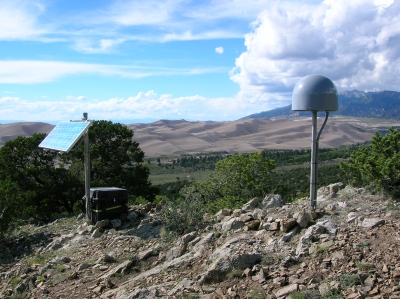| Item | Approximate Cost |
P/N or Notes
| Source |
|---|
| GNSS Receivers |
$3,400 to $12,000
|
Including antenna, Price depends on model and quantity ordered, PBO standard is Trimble NetRS with Choke Ring antenna |
See UNAVCO Member Purchase Program for vendor contact |
| Monuments |
.
|
.
|
.
|
| Short Drilled Braced Monument |
$650
|
Plus required tools |
Various. - See UNAVCO SDB monument web page |
| Deep Drilled Braced Monument |
$8,000 to $15,000
|
Depending on location, specialized drill rig required |
Various. - See UNAVCO DDB monument web page |
| Equipment Enclosure w/ DC backpanel |
$950
|
.
|
Various. - See UNAVCO enclosure web page |
| Solar DC Power System |
.
|
.
|
.
|
| 2 x ~100 Ahr Gel battery |
$250
|
Alternative - DEKA/MK 12-volt, 100-AH, Gel battery, or Similar
|
|
| 2 x 72-80 W Solar Panels |
$900
|
Depending on Location
|
|
| Solar panel mount |
$200
|
Two panel model |
Precision Design & Machine 6595 Odell Place, Suite F, Boulder, CO 80301, Tel. 303-527-3049, PDMachine@msn.com |
| SCIGN antenna mount |
$550
|
See information on UNAVCO web site |
SCEC University of Southern California 3651 Trousdale Parkway, Suite 169 Los Angeles, California, 90089-0742 John McRaney, Tel. 213-740-5842
or
Precision Design & Machine 6595 Odell Place, Suite F, Boulder, CO 80301 Tel. 303-527-3049
|
| SCIGN radome (tall model) |
$220
|
See information on UNAVCO web site |
SCEC University of Southern California 3651 Trousdale Parkway, Suite 169 Los Angeles, California, 90089-0742 John McRaney, Tel. 213-740-5842 |
| Cellular Communications |
.
|
.
|
.
|
| Cellular modem |
$795
|
Proxicast LAN-Cell Mobile Gateway Model 1XMG-401 - TDMA or ModelGPRS-401-GSM |
Proxicast 312 Sunnyfield Drive, Suite 200 Pittsburgh, PA 15116-1936 Tel. 877-777-7694 |
| Cellular antenna |
$50
|
MaxRad WMLPVDB 800/1900 |
Hutton Communications 2520 Marsh Lane, Carrollton, TX 75006 Tel. 877-648-8866
|
| Antenna L-Bracket |
$15
|
MaxRad MMK1924 |
Hutton Communications 2520 Marsh Lane, Carrollton, TX 75006 Tel. 877-648-8866 |
| Antenna base |
$50
|
MaxRad MVP |
Hutton Communications 2520 Marsh Lane, Carrollton, TX 75006 Tel. 877-648-8866 |
| Communications Service |
$60-80/month
|
Verizon or Cingular depending on coverage area |
Verizon Wireless P.O. Box 4001, Inglewood, CA 90313-4001 Tel. 888-466-4646
Cingular Wireless PO Box 30218, Los Angeles, CA 90030-0218 Tel. 800-331-0500
|
| Ethernet Radio |
$1100 to 1300
|
Intuicom EB6 Plus - Price depends on quantity ordered, 2 or more required, includes antennas and cables, used for bridging to cellular or other internet connection |
See UNAVCO Member Purchase Program for vendor contact |
| Misc Supplies |
.
|
.
|
|
| 2 x N connector for LMR 400 cable - |
$10 ea.
|
EZ-400-NMH |
Hutton Communications, 2520 Marsh Lane, Carrollton, TX 75006, Tel. 877-648-8866 |
| N-type 90° connector |
$10 ea.
|
EX400NMH-RA |
Hutton Communications, 2520 Marsh Lane, Carrollton, TX 75006, Tel. 877-648-8866 |
| Liquitite conduit and connectors |
$40
|
.
|
Graybar, Inc. 1375 W. 47th Ave., Denver, CO 80211 Tel. 303-458-7770 |

![]() unavco.org.
unavco.org.